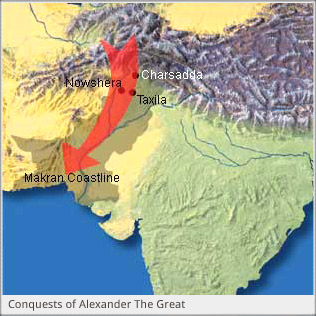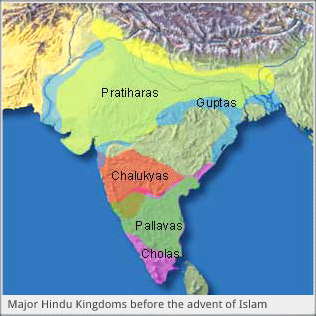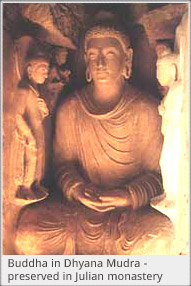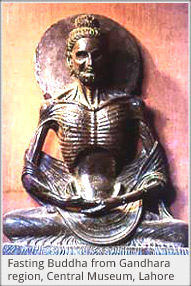Some of the earliest relics of Stone Age man were found in the Soan valley near Rawalpindi, dating back to at least 50,000 years. Predominantly an agricultural region, its inhabitants learned to tame and husband animals and cultivate crops some 9,000 years ago. Farming villages dating from 6000 BC have been excavated in Baluchistan, the North West Frontier Province and Punjab.
The Indus Valley Civilization is considered to have evolved around 2600 BC. Built on the ruins of fortified towns near Kot Diji, it is now believed to have emerged from farming communities of the area. The Civilization boasted immense cities like Moenjodaro and Harappa. These towns were well planned, with paved main roads, multistoried houses, watchtowers, food warehouses, and assembly halls. Their people developed an advanced script that still remains un-deciphered. The Indus Civilization’s decline around 1700 BC is attributed to foreign invaders, who at some sites violently destroyed the cities. But with recent research, historians have become unsure as to the exact causes of decline of the Indus Civilization.
Aryans, who were rough cattle breeders, came from Central Asia around 1700 BC, seeking grazing land for their herds. Their religion was well developed, with gods identified from elements of nature. They followed a strict caste system, which later became Hinduism. They wrote the first book of Hindu scripture, the Rig Veda, which was a collection of hymns remembered through several generations. Some anthropologists believe that there is no real historical evidence to prove the coming of Aryans, and consider their coming as a myth.
In sixth century BC, the people of the region were getting increasingly dissatisfied with the Hindu caste system. When Buddha, son of a Kshatriya king preached equality in men, his teachings were quickly accepted throughout the northern part of the Sub-continent. Around the same time Gandhara, being the easternmost province of the Achaemenid Empire of Persia, became a major power in the region. Its two cities – Pushkalavati, or present day Charsadda near Peshawar, and the capital Taxila, were the center of civilization and culture.
 Alexander the Great invaded the Sub-continent in 327 BC. Conquering the Kalash valley, he crossed the mighty Indus at Ohind, sixteen miles north of Attock. He then defeated the mighty elephant army of Porus at Jhelum, and began his march towards the long Ganges plain. However, he was forced to plan for homeward sailing when his war-wary troops refused to advance further. On his way back, a serious wound, received while battling the Malloi people at Multan, finally took its toll, and Alexander died in 323 BC, leaving his conquests for grab among his own officers.
Alexander the Great invaded the Sub-continent in 327 BC. Conquering the Kalash valley, he crossed the mighty Indus at Ohind, sixteen miles north of Attock. He then defeated the mighty elephant army of Porus at Jhelum, and began his march towards the long Ganges plain. However, he was forced to plan for homeward sailing when his war-wary troops refused to advance further. On his way back, a serious wound, received while battling the Malloi people at Multan, finally took its toll, and Alexander died in 323 BC, leaving his conquests for grab among his own officers.
Chandragupta Maurya was an exiled member of the royal family of Magadha, a kingdom flourishing since 700 BC on the bank of river Ganges. After Alexander’s death, Chandragupta captured Punjab with his allies, and later overthrew the king of Magadha in 321 BC to form the Mauryan Empire. After twenty-four years of kingship, his son, Bindusara, who added Deccan to the Mauryan rule, succeeded Chandragupta.
Ashoka, son of Bindusara, was one of the greatest rulers the world has ever known. Not only did he rule a vast empire; he  also tried to rule it compassionately. After initially causing thousands of lives during his conquest of Kalinga, he decided to rule by the law of piety. He was instrumental in spreading Buddhism within and outside the Sub-continent by building Buddhist monasteries and stupas, and sending out missionaries to foreign lands.
also tried to rule it compassionately. After initially causing thousands of lives during his conquest of Kalinga, he decided to rule by the law of piety. He was instrumental in spreading Buddhism within and outside the Sub-continent by building Buddhist monasteries and stupas, and sending out missionaries to foreign lands.
The Greek king of Bactria, Demetrius, conquered the Kabul River Valley around 195 BC. The Greeks re-built Taxila and Pushkalavati as their twin capital cities in Gandhara. They were followed in 75 BC by the Scythians, Iranian nomads from Central Asia, and in about 50 BC by the powerful Parthians, from east of the Caspian Sea.
After defeating the Greeks in 53 BC, the Parthians ruled the northern Pakistan area. During their era of trade and economic prosperity, the Parthians promoted art and religion. The Gandhara School of art developed, which reflected the glory of Greek, Syrian, Persian and Indian art traditions.
 The Kushana king, Kujula, ruler of nomad tribes from Central Asia, overthrew the Parthians in 64 AD and took over Gandhara. The Kushans further extended their rule into northwest India and Bay of Bengal, south into Bahawalpur and short of Gujrat, and north till Kashghar and Yarkand, into the Chinese frontier. They made their winter capital at Purushapura, the City of Flowers, now called Peshawar, and their summer capital north of Kabul.
The Kushana king, Kujula, ruler of nomad tribes from Central Asia, overthrew the Parthians in 64 AD and took over Gandhara. The Kushans further extended their rule into northwest India and Bay of Bengal, south into Bahawalpur and short of Gujrat, and north till Kashghar and Yarkand, into the Chinese frontier. They made their winter capital at Purushapura, the City of Flowers, now called Peshawar, and their summer capital north of Kabul.
Kanishka, the greatest of Kushans, ruled from the year 128 to 151. Trade flourished during his rule, with the Romans trading in gold for jewelry, perfumes, dyes, spices and textiles. Progress was made in medicine and literature. Thousands of Buddhist monasteries and stupas were built and the best pieces of sculpture in the Gandhara School of art were produced. He was killed in his sleep when his own people resisted his unending expansionist pursuits.
The Kushans Empire was usurped both from the North, where the Sassanian Empire of Persia eroded their rule. and the South where the Gupta Empire took hold. In the fourth century, due to decline in prosperity and trade, the Kushans Empire was reduced to a new dynasty of Kidar (Little) Kushans, with the capital now at Peshawar.
Coming from Central Asia, the White Huns, originally the horse-riding nomads from China, invaded Gandhara during the fifth century. With declining prosperity, and the sun and fire-worshipping Huns ruling the land, Buddhism gradually disappeared from northern Pakistan, taking the glory of the Gandhara School of art with it.
After the defeat of Huns by Sassanians and Turks in 565, the area was mostly left to be ruled by small Hindu kingdoms, with the Turki Shahi rulers controlling the area till Gandhara from Afghanistan, and the raja of Kashmir ruling northern Punjab, and the areas east of the Indus. Buddhism’s decline continued as more people were converted to Brahman Hindus.
 Overthrowing the Turki Shahis, the Central Asian Hindu Shahis ruled from 870 till the year 1008. With their capital established at Hund on the Indus, their rule extended from Jalalabad in Afghanistan to Multan, and covered as far north as Kashmir.
Overthrowing the Turki Shahis, the Central Asian Hindu Shahis ruled from 870 till the year 1008. With their capital established at Hund on the Indus, their rule extended from Jalalabad in Afghanistan to Multan, and covered as far north as Kashmir.
This article was last updated on Sunday, June 01, 2003






